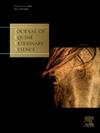The semen microbiome influences the mare uterine microbiome
IF 1.3
3区 农林科学
Q2 VETERINARY SCIENCES
引用次数: 0
Abstract
The uterine microbiome has been well characterized in farm animals, including horses, and associations between the semen microbiome and uterine microbiome have been described in humans but unknown in horses. Of interest is that high bacterial richness in semen was linked to dysbiosis in the vaginal microbiome of sub-fertile humans. An extra-species model (donkey-to- and horse-to-mare) was designed to determine the effects of the male seminal microbiome on the mare uterine microbiome. This study hypothesizes that the semen microbiome of the horse differs from the jack's, which could trigger distinct post-breeding changes in the mare uterine microbiome. Twenty-two fertile mares were inseminated with a single fertile donkey jack or horse stallion raw semen (2 billion total sperm) in a cross-over design with a washout cycle in between. A sample of uterine fluid was collected before the insemination and after 6h, 24h, and at the embryo flush 8d post-ovulation. Bacterial DNA was purified from semen and uterine fluid with a commercial kit (QIAGEN, QIamp DNA microbiome kit) and submitted for PCR amplification and sequencing of the full-length 16S region. Taxonomy assignments were done via QIIME2, and R was used for the analyses. The dataset was filtered and agglomerated per rank to the Family level. Alpha and beta diversity indexes were calculated and compared with the Wilcoxon rank-sum test, a linear mixed model, and PERMANOVA; significance was set at P〈 0.05. Alpha diversity (Faith's PD index) differed between donkey and horse semen (P=0.048), whereas beta diversity was similar across species (P 〉0.05). The most prevalent Phyla in mares bred to the donkey were Proteobacteria (50.3%), Actinobacteria (18%), and Firmicutes (29.8%) similarly, in mares bred to the horse, Proteobacteria (62.5%), Actinobacteria (21.7%), and Firmicutes (12.3%) were the most abundant. Noteworthy, the Order of Lactobacillales bacteria contributed up to 20% of the microbiome composition in mares bred to the donkey jack and up to 6% in mares bred to the horse stallion. Twenty-four bacteria families were found to have a common relationship between donkey semen and the mare uterus after the insemination, and nine were identified between horse semen and the uterus. Species richness and evenness (alpha diversity) were not different in mares with a positive or a negative embryo flush (Observed ASVs, P=0.11; Chao1, P=0.22; Shannon, P=0.91; Simpson, P=0.19, Faith's PD, P=0.70). The beta diversity of the uterus 8d post-ovulation differed based on the embryo outcome in both mares bred to the donkey or the horse (R-squared=0.069; F-value=2.01; P=0.02). In conclusion, the semen microbiome varied between the two equids used in the study, and more importantly, the semen microbiome affected the mare uterine microbiome and suggested for the first time in the horse that the presence of a temporary combined male and female microbiome has apparent consequences for the embryonic recovery.
求助全文
约1分钟内获得全文
求助全文
来源期刊

Journal of Equine Veterinary Science
农林科学-兽医学
CiteScore
2.70
自引率
7.70%
发文量
249
审稿时长
77 days
期刊介绍:
Journal of Equine Veterinary Science (JEVS) is an international publication designed for the practicing equine veterinarian, equine researcher, and other equine health care specialist. Published monthly, each issue of JEVS includes original research, reviews, case reports, short communications, and clinical techniques from leaders in the equine veterinary field, covering such topics as laminitis, reproduction, infectious disease, parasitology, behavior, podology, internal medicine, surgery and nutrition.
 求助内容:
求助内容: 应助结果提醒方式:
应助结果提醒方式:


